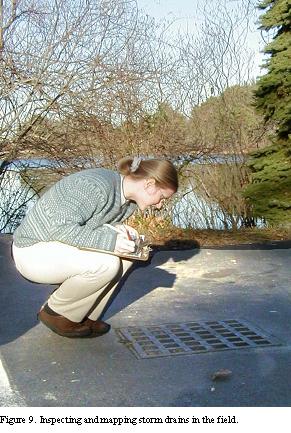We have a new stormwater page with updated maps and data!
Under the Buzzards Bay Stormwater Collaborative initiative, we are working with Buzzards Bay municipalities to update our stormwater database and to monitor water quality from stormwater discharges. Information about this new initiative and a new interactive map showing catchbasins and discharges in Buzzards Bay watershed towns are available at stormwater.buzzardsbay.org.
2012 Stormwater Atlas File Updates and Google Earth Files
Below, we provide links to the March 2012 updates to our GIS database of stormwater and catch basin information. Due to the size of the New Bedford data set, we provide that catch basin data set in a separate file. The data has been compiled from various municipal and other sources, including fieldwork by Buzzards Bay NEP staff and BBAC interns. Consequently, locations and information have different levels of positional and informational accuracy. These data sets should not be used as substitutes for field survey work, but is suitable for planning and subwatershed pollution studies.
Map of known discharges. (Blue circle is a pipe, magenta triangle is a road cut.)

Background
Rainwater running off streets, parking lots, roofs, lawns, golf courses, agricultural land and other pervious and impervious areas carries contaminants into bays, rivers, and ponds. Some stormwater contaminants like bacteria, are forcing the closure of shellfish beds and sometimes the temporary closure of swimming beaches around Buzzards Bay. Most often, paved roads and parking lots that are connected to Buzzards Bay by drainpipes and road-cuts offer direct pathways for contaminants that were once isolated from the Bay.
Beginning around 2000, the BBNEP began assembling data on the location of all known discharge pipes and catch basins in the Buzzards Bay watershed. This work culminated in 2003 with the “Atlas of Stormwater Discharges in the Buzzards Bay Watershed.” This stormwater atlas was meant to inventory, in maps and tables, all known stormwater discharge pipes and road-cuts discharging to tidal waters in the Buzzards Bay basin (the City of New Bedford and the island Town of Gosnold were not included in the study.). It also identified all known contributing catch basins and surface areas for each of these stormwater discharges. The report established priorities for remediation. This prioritization was based on the criteria described below. The original report was posted on this webpage, and since that time, we have made available updates to the database.
The 100-plus-page 2003 report and companion CD were distributed to municipal boards and local libraries. It included maps of more than 2,600 stormwater discharges and more than 12,000 catch basins along the shores of nearly all of Buzzards Bay. Boards of Selectmen, Departments of Public Works, Boards of Health, and Conservation Commissions received the document and poster size town-maps of their stormwater networks.
In 2007, the Buzzards Bay NEP updated and revised the stormwater drainage and discharge GIS database through the Stormwater Mapping Collaborative with the Buzzards Bay Action Committee and New Bedford Voc Tech.
Methods in the 2003 report
Prioritization Methodology for Individual Discharges and Shellfish Resource Areas
The purpose of this report is to inventory stormwater discharges to Buzzards Bay and their contributing drainage area, and to help establish remediation priorities based upon water quality, land use, estimated cost of remediation and potential benefit. To accomplish these goals, we have prioritized both individual stormwater discharges, and individual shellfish resource areas based upon a variety of parameters. To evaluate the shellfish resource areas and stormwater discharges, many common and somewhat overlapping data sets were used. In this report, the Designated Shellfish Growing Areas (DSGAs) boundaries employed by the Massachusetts Division of Marine Fisheries (DMF)were used as the management unit for evaluating and scoring both resource areas and stormwater discharges.
ArcViewTM Files
Zipped GIS file discharges: bbnep_discharges_2012.zip
Zipped GIS file catchbasins: bbnep_catchbasins_2012.zip
Zipped GIS file flows: bbnep_flows_2012.zip
Google Earth KMZ files: bbnep_catchbasins_2012.kml
discharges: bbnep_discharges_2012.kml
flows: bbnep_flows_2012.kml
New Bedford only data
The positions of these outfalls in some cases may have been modified somewhat from the original source material.
New Bedford discharges: nb_apr08_dichargepoint.zip (zipped shape file)
Google Earth KMZ file: nb_apr08_dichargepoint.kmz
The location of some catch basins in this dataset seem doubtful. New Bedford catch basins: nb_apr2008_catchbasin.zip
Google Earth KMZ file: nb_apr2008_catchbasin.kmz
Note: on May 1 we fixed two of the links above and added a coordinate system to 1 zipped file).
Stormwater Discharge Prioritization To evaluate stormwater remediation sites, the following information was gathered for each discharge:
-number of catch basins in stormwater network
-length of stormwater collection system
-sewering of homes in drainage area
-Division of Marine Fisheries prioritization of existing shellfish resources
-estimated cost of remediation
-sensitivity of receiving waters to changes in pollution
2003 Results
Summary of stormwater discharges, by town.
| Town | pipe | road cut | total |
| Bourne | 168 | 63 | 231 |
| Dartmouth | 255 | 168 | 423 |
| Fairhaven | 221 | 25 | 246 |
| Falmouth | 202 | 40 | 242 |
| Marion | 227 | 53 | 280 |
| Mattapoisett | 276 | 42 | 318 |
| New Bedford | 21 | 12 | 33 |
| Wareham | 592 | 118 | 710 |
| Westport | 80 | 55 | 135 |
| GRAND TOTAL | 2042 | 576 | 2618 |
2003 Atlas Documents
The original 2003 atlas report. Graphics in this pdf file was degraded slightly to reduce file size.
Entire report (29 MB)
Town-Wide and Bay-Wide Poster Maps
11×17 2002 discharge priority map, topographic map base
Try this 34″ x 42″ discharge map with street names shown, only 600 kb.
Problems or Questions? Please email Joe Costa about this page.